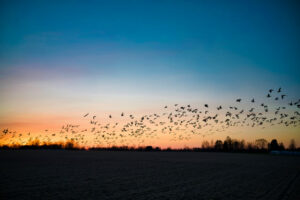The World Around Us:
Atlantic Flyway
It’s that time of year again when the New York skies are filled with birds migrating into and out of our state in preparation for the upcoming winter. This busy season begins in mid-August and runs through December. With millions of birds taking to the skies, one might expect chaos — but once again, nature’s brilliance shines.
The secret behind this seeming madness lies in the flyways. There are four major flyways in the United States: the Atlantic, Mississippi, Central, and Pacific.

The Atlantic Flyway runs north to south from Canada to the Gulf of Mexico and the Caribbean, and east to west from the eastern shore to the Appalachian Mountains. More than 500 species of birds from New York and beyond travel along this corridor, which spans approximately 1.6 million square miles, with much of it over coastlines and open water. Birds use this route to seek warmer climates and better feeding grounds. Not all birds however travel the entire length of the flyway — some migrate only a few hundred miles, while others journey thousands.
To navigate these vast distances, birds rely on multiple tools, including sensing the Earth’s magnetic fields, following landmarks like rivers and coastlines, using the sun and stars, and even their sense of smell.
This is a wonderful time of year for bird lovers to spot species that are not typically seen in our area. As waterfowl, shorebirds, ducks, and songbirds fill the skies, keep an eye out for Snow Geese, Buffleheads, Mallards, Song Sparrows, Eastern Bluebirds, Wood Thrushes, American Goldfinches, Red-winged Blackbirds, and Black-capped Chickadees, to name just a few. For a more detailed list, visit audubon.org.
To help these birds along their journey, New Yorkers are encouraged to:
• Turn off outdoor lights at night to avoid disorienting birds during nighttime flights.
• Place stickers or decals on windows to prevent collisions, especially for birds unfamiliar with the area.
• Keep water available.
• Avoid feeding ducks and birds bread or crackers, which are harmful to their health. Instead, visit your local bird supply store and choose natural seeds that provide proper nourishment and energy for migration.
• Protect natural habitats — such as wetlands, coastal areas, and forests — that serve as critical stopovers along their routes.
By taking these small steps, we can make a big difference in helping our feathered travelers complete their incredible journeys safely.
New York State Humane Association Humane Review, Vol.XLVI, Fall 2025.